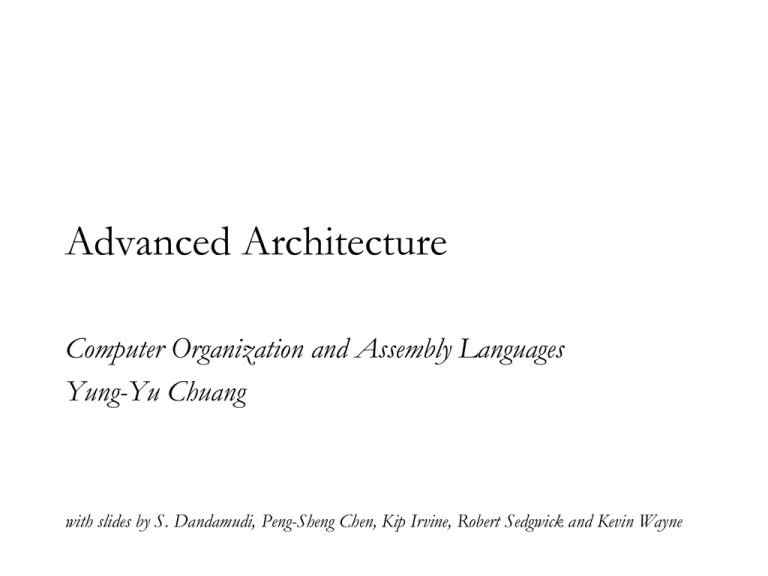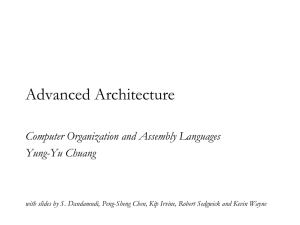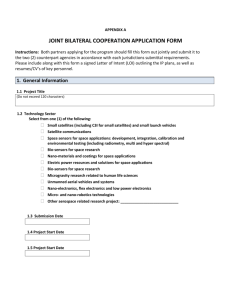ppt
advertisement

Advanced Architecture
Computer Organization and Assembly Languages
Yung-Yu Chuang
with slides by S. Dandamudi, Peng-Sheng Chen, Kip Irvine, Robert Sedgwick and Kevin Wayne
Basic architecture
Basic microcomputer design
• clock synchronizes CPU operations
• control unit (CU) coordinates sequence of
execution steps
• ALU performs arithmetic and logic operations
data bus
registers
Central Processor Unit
(CPU)
ALU
CU
clock
control bus
address bus
Memory Storage
Unit
I/O
Device
#1
I/O
Device
#2
Basic microcomputer design
• The memory storage unit holds instructions and
data for a running program
• A bus is a group of wires that transfer data from
one part to another (data, address, control)
data bus
registers
Central Processor Unit
(CPU)
ALU
CU
clock
control bus
address bus
Memory Storage
Unit
I/O
Device
#1
I/O
Device
#2
Clock
• synchronizes all CPU and BUS operations
• machine (clock) cycle measures time of a single
operation
• clock is used to trigger events
one cycle
1
0
• Basic unit of time, 1GHz→clock cycle=1ns
• An instruction could take multiple cycles to
complete, e.g. multiply in 8088 takes 50 cycles
Instruction execution cycle
program counter
instruction queue
PC
I-1
memory
op1
op2
program
I-2 I-3 I-4
fetch
read
registers
registers
write
decode
write
I-1
flags
ALU
execute
(output)
instruction
register
• Fetch
• Decode
• Fetch
operands
• Execute
• Store output
Pipeline
Multi-stage pipeline
• Pipelining makes it possible for processor to
execute instructions in parallel
• Instruction execution divided into discrete stages
Stages
S1
1
S3
S4
S5
I-1
3
I-1
4
I-1
5
I-1
6
7
8
9
10
11
12
S6
I-1
2
Cycles
Example of a nonpipelined processor.
For example, 80386.
Many wasted cycles.
S2
I-1
I-2
I-2
I-2
I-2
I-2
I-2
Pipelined execution
• More efficient use of cycles, greater throughput
of instructions: (80486 started to use pipelining)
Stages
Cycles
S1
1
I-1
2
I-2
3
4
5
6
7
S2
S3
S4
S5
S6
I-1
I-2
I-1
I-2
I-1
I-2
k + (n – 1)
I-1
I-2
For k stages and
n instructions, the
number of
required cycles is:
I-1
I-2
compared to k*n
Pipelined execution
• Pipelining requires buffers
– Each buffer holds a single value
– Ideal scenario: equal work for each stage
• Sometimes it is not possible
• Slowest stage determines the flow rate in the
entire pipeline
Pipelined execution
• Some reasons for unequal work stages
– A complex step cannot be subdivided conveniently
– An operation takes variable amount of time to
execute, e.g. operand fetch time depends on where
the operands are located
• Registers
• Cache
• Memory
– Complexity of operation depends on the type of
operation
• Add: may take one cycle
• Multiply: may take several cycles
Pipelined execution
• Operand fetch of I2 takes three cycles
– Pipeline stalls for two cycles
• Caused by hazards
– Pipeline stalls reduce overall throughput
Wasted cycles (pipelined)
• When one of the stages requires two or more
clock cycles, clock cycles are again wasted.
Stages
Cycles
S1
S2
S3
exe
S4
1
I-1
2
I-2
I-1
3
I-3
I-2
I-1
I-3
I-2
I-1
I-3
I-1
4
5
6
I-2
7
I-2
8
I-3
9
I-3
10
11
S5
S6
For k stages and n
instructions, the
number of required
cycles is:
I-1
I-1
I-2
I-2
I-3
I-3
k + (2n – 1)
Superscalar
A superscalar processor has multiple execution
pipelines. In the following, note that Stage S4
has left and right pipelines (u and v).
Stages
S4
Cycles
S1
S2
S3
u
v
S5
S6
1
I-1
2
I-2
I-1
3
I-3
I-2
I-1
4
I-4
I-3
I-2
I-1
I-4
I-3
I-1
I-2
I-4
I-3
I-2
I-1
I-3
I-4
I-2
I-1
I-4
I-3
I-2
I-4
I-3
5
6
7
8
9
10
For k states and n
instructions, the
number of required
cycles is:
k+n
I-4
Pentium: 2 pipelines
Pentium Pro: 3
Pipeline stages
•
•
•
•
Pentium 3: 10
Pentium 4: 20~31
Next-generation micro-architecture: 14
ARM7: 3
Hazards
• Three types of hazards
– Resource hazards
• Occurs when two or more instructions use the same
resource, also called structural hazards
– Data hazards
• Caused by data dependencies between instructions,
e.g. result produced by I1 is read by I2
– Control hazards
• Default: sequential execution suits pipelining
• Altering control flow (e.g., branching) causes
problems, introducing control dependencies
Data hazards
add r1, r2, #10
sub r3, r1, #20
fetch decode
reg
fetch decode
; write r1
; read r1
ALU
wb
stall
reg
ALU
wb
Data hazards
• Forwarding: provides output result as soon as
possible
add r1, r2, #10
sub r3, r1, #20
fetch decode
reg
fetch decode
; write r1
; read r1
ALU
wb
stall
reg
ALU
wb
Data hazards
• Forwarding: provides output result as soon as
possible
add r1, r2, #10
sub r3, r1, #20
fetch decode
reg
; write r1
; read r1
ALU
fetch decode
fetch decode stall
wb
stall
reg
ALU
reg
ALU
wb
wb
Control hazards
target:
bz r1, target
add r2, r4, 0
...
add r2, r3, 0
fetch decode
reg
fetch decode
ALU
wb
reg
ALU
wb
reg
ALU
wb
reg
ALU
wb
reg
ALU
fetch decode
fetch decode
fetch decode
Control hazards
• Braches alter control flow
– Require special attention in pipelining
– Need to throw away some instructions in the
pipeline
• Depends on when we know the branch is taken
• Pipeline wastes three clock cycles
– Called branch penalty
– Reducing branch penalty
• Determine branch decision early
Control hazards
• Delayed branch execution
– Effectively reduces the branch penalty
– We always fetch the instruction following the branch
• Why throw it away?
• Place a useful instruction to execute
• This is called delay slot
Delay slot
add
R2,R3,R4
branch
target
branch
target
add
R2,R3,R4
sub
R5,R6,R7
sub
R5,R6,R7
. . .
. . .
Branch prediction
• Three prediction strategies
– Fixed
• Prediction is fixed
– Example: branch-never-taken
» Not proper for loop structures
– Static
• Strategy depends on the branch type
– Conditional branch: always not taken
– Loop: always taken
– Dynamic
• Takes run-time history to make more accurate predictions
Branch prediction
• Static prediction
– Improves prediction accuracy over Fixed
Instruction type
Unconditional
branch
Conditional
branch
Loop
Call/return
Instruction
Distribution
(%)
70*0.4 = 28
Prediction:
Correct
Branch
prediction
taken?
(%)
Yes
28
70*0.6 = 42
No
42*0.6 = 25.2
10
Yes
10*0.9 = 9
20
Yes
20
Overall prediction accuracy = 82.2%
Branch prediction
• Dynamic branch prediction
– Uses runtime history
• Takes the past n branch executions of the branch type and
makes the prediction
– Simple strategy
• Prediction of the next branch is the majority of the
previous n branch executions
• Example: n = 3
– If two or more of the last three branches were taken, the
prediction is “branch taken”
• Depending on the type of mix, we get more than 90%
prediction accuracy
Branch prediction
• Impact of past n branches on prediction
accuracy
n
0
1
2
3
4
5
Type of mix
Compiler Business Scientific
64.1
64.4
70.4
91.9
95.2
86.6
93.3
96.5
90.8
93.7
96.6
91.0
94.5
96.8
91.8
94.7
97.0
92.0
Branch prediction
00
no
branch
Predict
no branch
branch
01
Predict
no branch
no
branch
no
branch
branch
10
Predict
branch
no
branch
branch
11
Predict
branch
branch
Multitasking
• OS can run multiple programs at the same time.
• Multiple threads of execution within the same
program.
• Scheduler utility assigns a given amount of CPU
time to each running program.
• Rapid switching of tasks
– gives illusion that all programs are running at once
– the processor must support task switching
– scheduling policy, round-robin, priority
Cache
SRAM vs DRAM
data bus
registers
Central Processor Unit
(CPU)
ALU
CU
Memory Storage
Unit
I/O
Device
#1
I/O
Device
#2
clock
control bus
address bus
Tran. Access Needs
per bit time refresh? Cost
SRAM 4 or 6
DRAM
1
Applications
1X
No
100X
cache memories
10X
Yes
1X
Main memories,
frame buffers
The CPU-Memory gap
The gap widens between DRAM, disk, and CPU speeds.
100,000,000
10,000,000
1,000,000
Disk seek time
ns
100,000
DRAM access time
10,000
SRAM access time
1,000
CPU cycle time
100
10
1
1980
1985
1990
1995
2000
year
Access time
(cycles)
register
cache
memory
disk
1
1-10
50-100
20,000,000
Memory hierarchies
• Some fundamental and enduring properties of
hardware and software:
– Fast storage technologies cost more per byte, have
less capacity, and require more power (heat!).
– The gap between CPU and main memory speed is
widening.
– Well-written programs tend to exhibit good locality.
• They suggest an approach for organizing
memory and storage systems known as a
memory hierarchy.
Memory system in practice
L0:
registers
Smaller, faster, and
more expensive (per
byte) storage devices
L1: on-chip L1
cache (SRAM)
L2:
L3:
Larger, slower, and
cheaper (per byte)
L4:
storage devices
L5:
off-chip L2
cache (SRAM)
main memory
(DRAM)
local secondary storage (virtual memory)
(local disks)
remote secondary storage
(tapes, distributed file systems, Web servers)
Reading from memory
• Multiple machine cycles are required when reading
from memory, because it responds much more slowly
than the CPU (e.g.33 MHz). The wasted clock cycles are
called wait states.
Regs.
L1 Data
1 cycle latency
16 KB
4-way assoc
Write-through
32B lines
L1 Instruction
16 KB, 4-way
32B lines
Processor Chip
L2 Unified
128KB--2 MB
4-way assoc
Write-back
Write allocate
32B lines
Main
Memory
Up to 4GB
Pentium III cache hierarchy
Cache memory
• High-speed expensive static RAM both inside
and outside the CPU.
– Level-1 cache: inside the CPU
– Level-2 cache: outside the CPU
• Cache hit: when data to be read is already in
cache memory
• Cache miss: when data to be read is not in
cache memory. When? compulsory, capacity
and conflict.
• Cache design: cache size, n-way, block size,
replacement policy
Caching in a memory hierarchy
level k
8
4
3
9
14
10
4
Data is copied between levels
in block-sized transfer units
10
level
k+1
Smaller, faster, more
Expensive device at
level k caches a
subset of the blocks
from level k+1
0
1
2
3
4
5
6
7
8
9
10
11
12
13
14
15
Larger, slower, cheaper
Storage device at level
k+1 is partitioned into
blocks.
General caching concepts
14
12
level
k
0
1
2
3
4*
12
9
14
3
12
4*
level
k+1
Request
Request
14
12
Request
12
0
1
2
3
4
4*
5
6
7
8
9
10
11
12
13
14
15
• Program needs object d, which is
stored in some block b.
• Cache hit
– Program finds b in the cache at
level k. E.g., block 14.
• Cache miss
– b is not at level k, so level k cache
must fetch it from level k+1.
E.g., block 12.
– If level k cache is full, then some
current block must be replaced
(evicted). Which one is the “victim”?
• Placement policy: where can the new
block go? E.g., b mod 4
• Replacement policy: which block
should be evicted? E.g., LRU
Locality
• Principle of Locality: programs tend to reuse
data and instructions near those they have used
recently, or that were recently referenced
themselves.
– Temporal locality: recently referenced items are
likely to be referenced in the near future.
– Spatial locality: items with nearby addresses tend to
be referenced close together in time.
• In general, programs with good locality run
faster then programs with poor locality
• Locality is the reason why cache and virtual
memory are designed in architecture and
operating system. Another example is web
browser caches recently visited webpages.
Locality example
sum = 0;
for (i = 0; i < n; i++)
sum += a[i];
return sum;
• Data
– Reference array elements in succession (stride-1
reference pattern): Spatial locality
– Reference sum each iteration: Temporal locality
• Instructions
– Reference instructions in sequence: Spatial locality
– Cycle through loop repeatedly: Temporal locality
Locality example
• Being able to look at code and get a qualitative
sense of its locality is important. Does this
function have good locality?
int sum_array_rows(int a[M][N])
{
int i, j, sum = 0;
for (i = 0; i < M; i++)
for (j = 0; j < N; j++)
sum += a[i][j];
return sum;
} stride-1 reference pattern
Locality example
• Does this function have good locality?
int sum_array_cols(int a[M][N])
{
int i, j, sum = 0;
for (j = 0; j < N; j++)
for (i = 0; i < M; i++)
sum += a[i][j];
return sum;
} stride-N reference pattern
Blocked matrix multiply performance
• Blocking (bijk and bikj) improves performance
by a factor of two over unblocked versions (ijk
and jik)
– relatively insensitive to array size.
60
kji
jki
kij
ikj
jik
ijk
bijk (bsize = 25)
bikj (bsize = 25)
40
30
20
10
75
10
0
12
5
15
0
17
5
20
0
22
5
25
0
27
5
30
0
32
5
35
0
37
5
40
0
50
0
25
Cycles/iteration
50
Array size (n)
Cache-conscious programming
• make sure that memory is cache-aligned
• Split data into hot and cold (list example)
• Use union and bitfields to reduce size and
increase locality
RISC v.s. CISC
Trade-offs of instruction sets
compiler
high-level language
semantic gap
C, C++
Lisp, Prolog, Haskell…
machine code
• Before 1980, the trend is to increase instruction
complexity (one-to-one mapping if possible) to
bridge the gap. Reduce fetch from memory.
Selling point: number of instructions,
addressing modes. (CISC)
• 1980, RISC. Simplify and regularize instructions
to introduce advanced architecture for better
performance, pipeline, cache, superscalar.
RISC
• 1980, Patternson and Ditzel (Berkeley),RISC
• Features
– Fixed-length instructions
– Load-store architecture
– Register file
• Organization
– Hard-wired logic
– Single-cycle instruction
– Pipeline
• Pros: small die size, short development time,
high performance
• Cons: low code density, not x86 compatible
RISC Design Principles
• Simple operations
– Simple instructions that can execute in one cycle
• Register-to-register operations
– Only load and store operations access memory
– Rest of the operations on a register-to-register basis
• Simple addressing modes
– A few addressing modes (1 or 2)
• Large number of registers
– Needed to support register-to-register operations
– Minimize the procedure call and return overhead
RISC Design Principles
• Fixed-length instructions
– Facilitates efficient instruction execution
• Simple instruction format
– Fixed boundaries for various fields
• opcode, source operands,…
CISC and RISC
• CISC – complex instruction set
– large instruction set
– high-level operations (simpler for compiler?)
– requires microcode interpreter (could take a long
time)
– examples: Intel 80x86 family
• RISC – reduced instruction set
–
–
–
–
–
small instruction set
simple, atomic instructions
directly executed by hardware very quickly
easier to incorporate advanced architecture design
examples: ARM (Advanced RISC Machines) and DEC
Alpha (now Compaq), PowerPC, MIPS
CISC and RISC
CISC
(Intel 486)
RISC
(MIPS R4000)
#instructions
235
94
Addr. modes
11
1
1-12
4
8
32
Inst. Size (bytes)
GP registers
Why RISC?
• Simple instructions are preferred
– Complex instructions are mostly ignored by
compilers
• Due to semantic gap
• Simple data structures
– Complex data structures are used relatively
infrequently
– Better to support a few simple data types efficiently
• Synthesize complex ones
• Simple addressing modes
– Complex addressing modes lead to variable length
instructions
• Lead to inefficient instruction decoding and scheduling
Why RISC? (cont’d)
• Large register set
– Efficient support for procedure calls and returns
• Patterson and Sequin’s study
– Procedure call/return: 12-15% of HLL statements
» Constitute 31-33% of machine language instructions
» Generate nearly half (45%) of memory references
– Small activation record
• Tanenbaum’s study
– Only 1.25% of the calls have more than 6 arguments
– More than 93% have less than 6 local scalar variables
– Large register set can avoid memory references
ISA design issues
Instruction set design
• Issues when determining ISA
– Instruction types
– Number of addresses
– Addressing modes
Instruction types
•
•
•
•
Arithmetic and logic
Data movement
I/O (memory-mapped, isolated I/O)
Flow control
– Branches (unconditional, conditional)
• set-then-jump (cmp AX, BX; je target)
• Test-and-jump (beq r1, r2, target)
– Procedure calls (register-based, stack-based)
• Pentium: ret; MIPS: jr
• Register: faster but limited number of parameters
• Stack: slower but more general
Operand types
• Instructions support basic data types
– Characters
– Integers
– Floating-point
• Instruction overload
– Same instruction for different data types
– Example: Pentium
mov
mov
mov
AL,address
AX,address
EAX,address
;loads an 8-bit value
;loads a 16-bit value
;loads a 32-bit value
Operand types
• Separate instructions
– Instructions specify the operand size
– Example: MIPS
lb
lh
Rdest,address
Rdest,address
lw
Rdest,address
ld
Rdest,address
;loads a byte
;loads a halfword
;(16 bits)
;loads a word
;(32 bits)
;loads a doubleword
;(64 bits)
Number of addresses
Number of addresses
• Four categories
– 3-address machines
• two for the source operands and one for the result
– 2-address machines
• One address doubles as source and result
– 1-address machine
• Accumulator machines
• Accumulator is used for one source and result
– 0-address machines
• Stack machines
• Operands are taken from the stack
• Result goes onto the stack
Number of addresses
Number of
addresses
instruction
operation
3
OP A, B, C
A ← B OP C
2
OP A, B
A ← A OP B
1
OP A
AC ← AC OP A
0
OP
T ← (T-1) OP T
A, B, C: memory or register locations
AC: accumulator
T: top of stack
T-1: second element of stack
3-address
Example: RISC machines, TOY
A- B
Y
C (D E)
SUB Y, A, B
; Y = A - B
opcode
MUL T, D, E
ADD T, T, C
DIV Y, Y, T
; T = D ×E
; T = T + C
; Y = Y / T
A
B
C
2-address
A- B
Y
C (D E)
Example: IA32
MOV Y, A
SUB Y, B
MOV T, D
; Y = A
; Y = Y - B
; T = D
MUL T, E
ADD T, C
DIV Y, T
; T = T ×E
; T = T + C
; Y = Y / T
opcode
A
B
1-address
Example: IA32’s MUL (EAX)
A- B
Y
C (D E)
LD
D
; AC = D
opcode
MUL
ADD
ST
LD
SUB
DIV
ST
E
C
Y
A
B
Y
Y
;
;
;
;
;
;
;
AC = AC
AC = AC
Y = AC
AC = A
AC = AC
AC = AC
Y = AC
×E
+ C
– B
/ Y
A
0-address
Example: IA32’s FPU, HP3000
PUSH
PUSH
SUB
PUSH
PUSH
PUSH
MUL
ADD
DIV
POP
A
B
C
D
E
Y
;
;
;
;
;
;
;
;
;
A- B
Y
C (D E)
A
opcode
A, B
A-B
A-B, C
A-B, C, D
A-B, C, D, E
A-B, C, D× E
A-B, C+(D× E)
(A-B) / (C+(D× E))
Number of addresses
• A basic design decision; could be mixed
• Fewer addresses per instruction results in
– a less complex processor
– shorter instructions
– longer and more complex programs
– longer execution time
• The decision has impacts on register usage
policy as well
– 3-address usually means more generalpurpose registers
– 1-address usually means less
Addressing modes
Addressing modes
• How to specify location of operands? Trade-off
for address range, address flexibility, number
of memory references, calculation of addresses
• Operands can be in three places
– Registers
• Register addressing mode
– Part of instruction
• Constant
• Immediate addressing mode
• All processors support these two addressing modes
– Memory
• Difference between RISC and CISC
• CISC supports a large variety of addressing modes
• RISC follows load/store architecture
Addressing modes
• Common addressing modes
–
–
–
–
–
–
–
–
Implied
Immediate (lda R1, 1)
Direct (st R1, A)
Indirect
Register (add R1, R2, R3)
Register indirect (sti R1, R2)
Displacement
Stack
Implied addressing
instruction
opcode
• No address field;
operand is implied by
the instruction
CLC ; clear carry
• A fixed and unvarying
address
Immediate addressing
instruction
opcode
operand
• Address field contains
the operand value
ADD 5; AC=AC+5
• Pros: no extra
memory reference;
faster
• Cons: limited range
Direct addressing
instruction
opcode address A
Memory
operand
• Address field contains
the effective address
of the operand
ADD A; AC=AC+[A]
• single memory
reference
• Pros: no additional
address calculation
• Cons: limited address
space
Indirect addressing
instruction
opcode address A
Memory
operand
• Address field contains
the address of a
pointer to the
operand
ADD [A]; AC=AC+[[A]]
• multiple memory
references
• Pros: large address
space
• Cons: slower
Register addressing
instruction
opcode
R
• Address field contains
the address of a
register
ADD R; AC=AC+R
operand
Registers
• Pros: only need a
small address field;
shorter instruction
and faster fetch; no
memory reference
• Cons: limited address
space
Register indirect addressing
instruction
opcode
R
Memory
• Address field contains
the address of the
register containing a
pointer to the operand
ADD [R]; AC=AC+[R]
Registers
operand
• Pros: large address
space
• Cons: extra memory
reference
Displacement addressing
• Address field could
contain a register
address and an address
instruction
opcode R
A
Memory
MOV EAX, [A+ESI*4]
• EA=A+[R×S] or vice
versa
• Several variants
+
Registers
operand
– Base-offset: [EBP+8]
– Base-index: [EBX+ESI]
– Scaled: [T+ESI*4]
• Pros: flexible
• Cons: complex
Displacement addressing
instruction
opcode R
A
MOV EAX, [A+ESI*4]
Memory
+
Registers
operand
• Often, register, called
indexing register, is
used for displacement.
• Usually, a mechanism
is provided to
efficiently increase the
indexing register.
Stack addressing
instruction
opcode
• Operand is on top of
the stack
ADD [R]; AC=AC+[R]
implicit
Stack
• Pros: large address
space
• Pros: short and fast
fetch
• Cons: limited by FILO
order
Addressing modes
Mode
Meaning
Implied
Pros
Cons
Fast fetch
Limited instructions
Immediate
Operand=A
No memory ref
Limited operand
Direct
EA=A
Simple
Limited address space
Indirect
EA=[A]
Large address space Multiple memory ref
Register
EA=R
No memory ref
Register
indirect
EA=[R]
Large address space Extra memory ref
Limited address space
Displacement EA=A+[R]
Flexibility
Complexity
stack
No memory ref
Limited applicability
EA=stack top
IA32 addressing modes
Effective address calculation (IA32)
8
A dummy format for one operand
3
3
2
8 or 32
base
index
s
displacement
register
file
shifter
adder
adder
memory
Based Addressing
• Effective address is computed as
base + signed displacement
– Displacement:
– 16-bit addresses: 8- or 16-bit number
– 32-bit addresses: 8- or 32-bit number
• Useful to access fields of a structure or record
• Base register points to the base address of the structure
• Displacement relative offset within the structure
• Useful to access arrays whose element size is
not 2, 4, or 8 bytes
• Displacement points to the beginning of the array
• Base register relative offset of an element within the
array
2003
S. Dandamudi
Chapter 11: Page 81
To be used with S. Dandamudi, “Fundamentals of Computer Organization and Design,” Springer, 2003.
Based Addressing
Indexed Addressing
• Effective address is computed as
(index * scale factor) + signed displacement
– 16-bit addresses:
– displacement: 8- or 16-bit number
– scale factor: none (i.e., 1)
– 32-bit addresses:
– displacement: 8- or 32-bit number
– scale factor: 2, 4, or 8
• Useful to access elements of an array
(particularly if the element size is 2, 4, or 8
bytes)
• Displacement points to the beginning of the array
• Index register selects an element of the array (array
index)
• Scaling factor size of the array element
Indexed Addressing
Examples
add
AX,[DI+20]
– We have seen similar usage to access parameters off the stack
add
AX,marks_table[ESI*4]
– Assembler replaces marks_table by a constant (i.e.,
supplies the displacement)
– Each element of marks_table takes 4 bytes (the scale factor
value)
– ESI needs to hold the element subscript value
add
AX,table1[SI]
– SI needs to hold the element offset in bytes
– When we use the scale factor we avoid such byte counting
Based-Indexed Addressing
Based-indexed addressing with no scale factor
• Effective address is computed as
base + index + signed displacement
• Useful in accessing two-dimensional arrays
• Displacement points to the beginning of the array
• Base and index registers point to a row and an element
within that row
• Useful in accessing arrays of records
• Displacement represents the offset of a field in a record
• Base and index registers hold a pointer to the base of the
array and the offset of an element relative to the base of
the array
Based-Indexed Addressing
• Useful in accessing arrays passed on to a
procedure
• Base register points to the beginning of the array
• Index register represents the offset of an element
relative to the base of the array
Example
Assuming BX points to table1
mov
AX,[BX+SI]
cmp
AX,[BX+SI+2]
compares two successive elements of table1
Based-Indexed Addressing
Based-indexed addressing with scale factor
• Effective address is computed as
base + (index * scale factor) + signed
displacement
• Useful in accessing two-dimensional arrays
when the element size is 2, 4, or 8 bytes
• Displacement ==> points to the beginning of the array
• Base register ==> holds offset to a row (relative to start of
array)
• Index register ==> selects an element of the row
• Scaling factor ==> size of the array element






